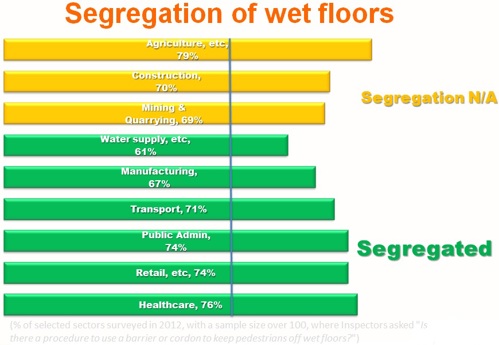Segregate Wet and Damp Floors to Control Slip Risks
Co-op prosecuted over pensioner’s fatal slip UPDATE (June, 2017) - "the aisle had not been cordoned off "
Employee who slipped in toilet and fractured his wrist awarded €65,000 (April, 2018) - "... cleaner ...removed the cleaning sign from the doorway when the floor was still wet after cleaning"
Steve Thorpe from HSL demonstrates pendulum slip resistance results of a dry floor, a wet floor and a “cleaned” floor (6 min, 7 second video)
- "Mop-dry" floors can be particularly hazardous as they look dry but are still slippery. Prevent or limit access until the floor is bone-dry
- Ensure proper safeguards if using a method that limits the amount of liquid on the floor such as spray mopping. A damp floor can be more dangerous than a wet floor as it may be just as slippery but it may look dry thus removing the visual warning. Prevent or limit access until the floor is bone-dry
- Segregate wet, damp or drying floor areas with a physical barrier or cordon until bone-dry - Segregation must not prevent emergency access/egress
- For larger floor areas, it may be necessary to wet-clean the floor in sections, segregating each section until bone-dry

A review of slip, trip and fall accidents where the floor was being wet cleaned showed that signs were ineffective in preventing all slips, trips and falls on wet floors.
- Signs should only be used where hazards cannot be avoided or adequately reduced - Signs may be used as a part of the cordon system
- Remove warning signs when they no longer apply (2.2 of Part B of Schedule 9 of the General Application Regulations)
Findings Regarding Segregation of Wet Floors
In 2012, 28% of 1,745 HSA workplace visits found the employer did not have a procedure to use a barrier or cordon to keep pedestrians off wet floors. |

A procedure to use a barrier or cordon to keep pedestrians off wet floors was found in over 60% of healthcare (88%), wholesale, retail (74%), public administration (74%), transport (71%), manufacturing (67%) and water supply, sewerage (61%) workplaces. Such a procedure was not applicable in the majority of agriculture (79%), construction (70%) and mining & quarrying (69%) premises. This could be because these sectors include large external areas or wet-working areas.
Drying wet-cleaned floors
- Floor drying methods can reduce the drying time but may not leave a floor totally dry. Partial floor drying can increase the risk of slips by removing the visual prompt to proceed with caution
- "Mop-dry" floors can be very slippery
- A dry mop, well-wrung mop or squeegee can reduce floor-drying time but a slip risk remains
- Exercise caution if using floor squeegees or scrubber-dryers with a squeegee which may not leave a floor bone-dry as the squeegee may be worn/ damaged
- Sufficient time must be allowed for floors to dry thoroughly
- It is not possible to establish a universal floor drying time
- Consider the potential to leave the floor to dry when the premises is unoccupied
- Floors take longer to dry at lower temperatures, e.g. cold rooms
- Damp meters are ineffective to find out if all floor surfaces are dry and safe

HSE UK has a wide range of case studies including housekeeping and cleaning regimes
Assessment of Slip Risks from Floor Cleaning
Floor cleaning is an important part of Slip Risk Assessment and Prevention
A risk assessment approach to Floor Wet Cleaning slips (trips and falls) can include the following steps

